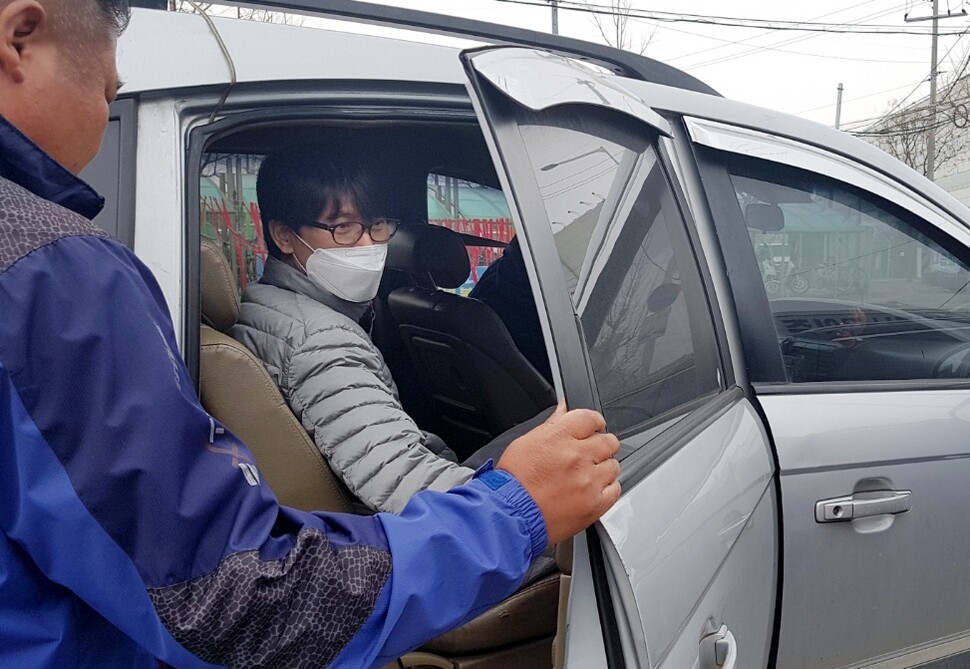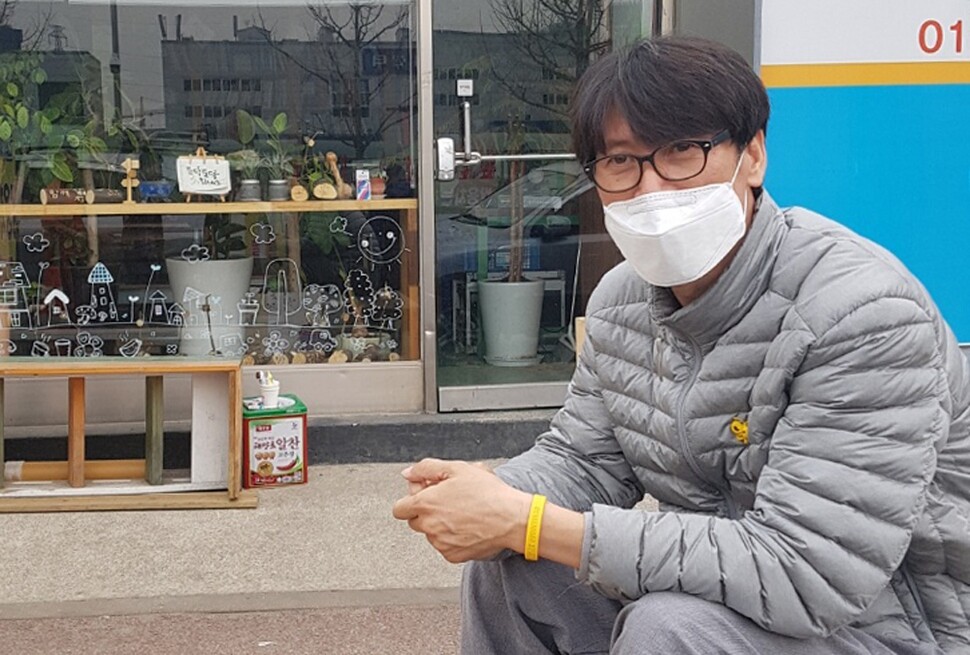hankyoreh
Links to other country sites 다른 나라 사이트 링크
Ssangyong Motors labor leader ends hunger strike after 32 days at the request of colleagues

At 8 am on Apr. 1, there was an unusual amount of activity in front of the Ssangyong Motors factory in the Chilgoe neighborhood of Pyeongtaek, Gyeonggi Province, beneath a heavily overcast sky. Workers hurried to work after being dropped off in front of the factory by a line of commuter buses. A new two-shift work arrangement was being implemented under which workers in the second shift could go home at 1 am instead of staying up all night. Most of the more than 3,000 workers at the factory had showed up that morning to receive the training they needed for the new work arrangement.
At the same time, the office of the Ssangyong Motors branch of the Korean Metal Workers' Union (KMWU), located across from the factory, was bustling with people for another reason. A crowd had gathered to see Kim Deuk-jung, leader of the union branch, who had been on a 32-day hunger strike, lasting from Feb. 28 until that very day. Kim had given up eating to demand the reinstatement of 130 people who had been fired by Ssangyong Motor in 2009 and were still out of a job 10 years later.
Kim was one of the workers who had been fired and had taken the lead in the fight for reinstatement, promising that he would be “the last person to return to work.” Early in the morning on Apr. 1, Kim mulled over the tearful appeals of coworkers at Ssangyong Motor and fellow union members to end his hunger strike. “I will stay alive and fight,” he wrote on social media as he brought his fast to an end.

“You’re upset with me, aren’t you?” Kim sheepishly said to the coworkers who dropped by to see him on their way to work. Because of his hunger strike, which had lasted for more than a month, he had lost 15kg, and he was so short of breath that he struggled with long conversations. But the colleagues who had been reinstated to their jobs before him encouraged him by patting his emaciated shoulders and hands and giving him a hug. “Why would we be upset about you stopping? You’ve gone through enough, so you ought to rest a little,” one of them said.
This was the fourth time that Kim had gone on a hunger strike to call for the reinstatement of the terminated workers. After his third hunger strike in 2015, which lasted for 45 days, the company, the union branch, and the corporate union agreed to try to reinstate the terminated workers by the first half of 2017. But during that time frame, only 37 workers were reinstated. Last year, Kim spent 53 days in India – the location of the Mahindra Group, Ssangyong Motors’ largest shareholder – which prompted labor and management to begin deliberations in February about bringing back the workers. But the company has refused to budge on his refusal to specify a deadline for reinstatement.
The company even responded to Kim’s hunger strike and a one-person protest in front of company premises organized by concerned citizens by issuing a threatening announcement on Mar. 27: “The union branch’s various protests and sit-ins are not helping efforts to reinstate the terminated workers and are only causing us to move further away from the negotiating table.”
“This hunger strike was borne out of my anger at the company for not implementing the agreement we had reached with such difficulty. The company has never apologized for failing to finish reinstating the workers by the first half of last year. It was hard both physical and emotionally for me to keep my rage from boiling over,” Kim told the Hankyoreh at the union branch office on Apr. 1.
Kim has admitted himself to Green Hospital in Seoul, where he plans to recuperate for the time being. Now that his hunger strike has brought fresh attention to the issue of the terminated workers, he is basically preparing for the next phase of his struggle. “Please stand with us and maintain the precious solidarity you have shown so far,” he said in expression of his gratitude.
Kim had the following message for his coworkers inside the factory: “Over the past ten years, we have been divided into those who stayed on the payroll and those who were let go, but if we don’t work together, we could suffer the same things again. Just as the terminated workers have not forgotten that they are always standing with their coworkers, I hope that our co-workers inside the factory have not forgotten us.”
By Park Tae-woo, staff reporter
Please direct questions or comments to [english@hani.co.kr]

Editorial・opinion
![[Column] Season 2 of special prosecutor probe may be coming to Korea soon [Column] Season 2 of special prosecutor probe may be coming to Korea soon](https://flexible.img.hani.co.kr/flexible/normal/500/300/imgdb/original/2024/0426/3317141030699447.jpg) [Column] Season 2 of special prosecutor probe may be coming to Korea soon
[Column] Season 2 of special prosecutor probe may be coming to Korea soon![[Column] Park Geun-hye déjà vu in Yoon Suk-yeol [Column] Park Geun-hye déjà vu in Yoon Suk-yeol](https://flexible.img.hani.co.kr/flexible/normal/500/300/imgdb/original/2024/0424/651713945113788.jpg) [Column] Park Geun-hye déjà vu in Yoon Suk-yeol
[Column] Park Geun-hye déjà vu in Yoon Suk-yeol- [Editorial] New weight of N. Korea’s nuclear threats makes dialogue all the more urgent
- [Guest essay] The real reason Korea’s new right wants to dub Rhee a founding father
- [Column] ‘Choson’: Is it time we start referring to N. Korea in its own terms?
- [Editorial] Japan’s rewriting of history with Korea has gone too far
- [Column] The president’s questionable capacity for dialogue
- [Column] Are chaebol firms just pizza pies for families to divvy up as they please?
- [Column] Has Korea, too, crossed the Rubicon on China?
- [Correspondent’s column] In Japan’s alliance with US, echoes of its past alliances with UK
Most viewed articles
- 1‘We must say no’: Seoul defense chief on Korean, USFK involvement in hypothetical Taiwan crisis
- 2N. Korean delegation’s trip to Iran shows how Pyongyang is leveraging ties with Moscow
- 3[Column] Season 2 of special prosecutor probe may be coming to Korea soon
- 4‘Weddingflation’ breaks the bank for Korean couples-to-be
- 5[Column] Has Korea, too, crossed the Rubicon on China?
- 6[Editorial] New weight of N. Korea’s nuclear threats makes dialogue all the more urgent
- 7[Reportage] On US campuses, student risk arrest as they call for divestment from Israel
- 8Korea sees more deaths than births for 52nd consecutive month in February
- 9[Column] Park Geun-hye déjà vu in Yoon Suk-yeol
- 10[Guest essay] The real reason Korea’s new right wants to dub Rhee a founding father